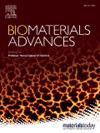BMP-2功能中空多孔微纤维支架巨噬细胞极化和骨再生
IF 6
2区 医学
Q2 MATERIALS SCIENCE, BIOMATERIALS
Materials Science & Engineering C-Materials for Biological Applications
Pub Date : 2025-07-21
DOI:10.1016/j.bioadv.2025.214425
引用次数: 0
摘要
人工骨替代物在生物材料领域引起了极大的关注,利用组织工程技术修复骨缺损已成为一种很有前景的替代方法。然而,当人工骨替代品植入体内时,它们会引起许多不良的细胞和组织免疫反应。本研究采用同轴静电纺丝技术制备了直径可控、力学性能优异、表面多孔结构的超细纤维。以聚(3-羟基丁酸-co-4-羟基丁酸)(P34HB)和聚乙二醇(PEG)为壳液,聚乙烯醇(PVA)和骨形态发生蛋白-2 (BMP-2)肽为核心液。与PVA/P34HB-PEG (P/P-P)支架相比,PVA- bmp -2/P34HB-PEG (P- b /P-P)支架使人单核白血病细胞系(THP-1细胞)更倾向于选择性活化的巨噬细胞(M2),这可以通过细胞中M2升高和经典活化的巨噬细胞(M1)表型标记物表达降低来证明。P-B/P-P微纤维具有调节巨噬细胞极化状态,诱导其向M2型分化,抑制周围组织炎症反应的潜力。此外,具有中空多孔结构的微纤维通过调节纤维直径,促进BMP-2肽的控释,促进小鼠颅骨来源的成骨前细胞系(MC3T3-E1)细胞向成骨方向分化,促进体内骨缺损的修复。本研究提出了调节骨免疫微环境,促进有效骨再生所必需的微纤维。本文章由计算机程序翻译,如有差异,请以英文原文为准。

Functional hollow porous microfiber scaffold with BMP-2 for macrophages polarization and bone regeneration
Artificial bone substitutes have garnered significant attention within the field of biomaterials, and the use of tissue engineering technology to repair bone defects has emerged as a promising alternative. However, when artificial bone substitutes are implanted in the body, they can induce many adverse cellular and tissue immune responses. In this study, we use coaxial electrospinning technology to fabricate microfiber with controllable diameter, excellent mechanical properties and surface porous structure. Poly(3-hydroxybutyrate-co-4-hydroxybutyrate) (P34HB) and polyethylene glycol (PEG) were used as shell solutions and polyvinyl alcohol (PVA) and bone morphogenetic protein-2 (BMP-2) peptides as core solutions. Compared to PVA/P34HB-PEG (P/P-P) scaffolds, PVA-BMP-2/P34HB-PEG (P-B/P-P) scaffolds polarized more human monocytic leukemia cell line (THP-1 cells) toward alternatively activated macrophages (M2), as demonstrated by increased M2 and decreased classically activated macrophage (M1) phenotypic marker expression in the cells. P-B/P-P microfibers have the potential to regulate the polarization state of macrophages, induce them to differentiate into an M2 phenotype and inhibit the inflammatory response of surrounding tissues. In addition, microfibers with a hollow porous structure facilitate the controlled release of BMP-2 peptides by regulating the fiber diameter, enhancing the differentiation of pre-osteoblastic cell line derived from mouse calvaria (MC3T3-E1) cells in an osteogenic direction and facilitating the repair of bone defects in vivo. This study presents microfibers essential for modulating the osteoimmune microenvironment, facilitating efficient bone regeneration.
求助全文
通过发布文献求助,成功后即可免费获取论文全文。
去求助
来源期刊
CiteScore
17.80
自引率
0.00%
发文量
501
审稿时长
27 days
期刊介绍:
Biomaterials Advances, previously known as Materials Science and Engineering: C-Materials for Biological Applications (P-ISSN: 0928-4931, E-ISSN: 1873-0191). Includes topics at the interface of the biomedical sciences and materials engineering. These topics include:
• Bioinspired and biomimetic materials for medical applications
• Materials of biological origin for medical applications
• Materials for "active" medical applications
• Self-assembling and self-healing materials for medical applications
• "Smart" (i.e., stimulus-response) materials for medical applications
• Ceramic, metallic, polymeric, and composite materials for medical applications
• Materials for in vivo sensing
• Materials for in vivo imaging
• Materials for delivery of pharmacologic agents and vaccines
• Novel approaches for characterizing and modeling materials for medical applications
Manuscripts on biological topics without a materials science component, or manuscripts on materials science without biological applications, will not be considered for publication in Materials Science and Engineering C. New submissions are first assessed for language, scope and originality (plagiarism check) and can be desk rejected before review if they need English language improvements, are out of scope or present excessive duplication with published sources.
Biomaterials Advances sits within Elsevier''s biomaterials science portfolio alongside Biomaterials, Materials Today Bio and Biomaterials and Biosystems. As part of the broader Materials Today family, Biomaterials Advances offers authors rigorous peer review, rapid decisions, and high visibility. We look forward to receiving your submissions!

 求助内容:
求助内容: 应助结果提醒方式:
应助结果提醒方式:


